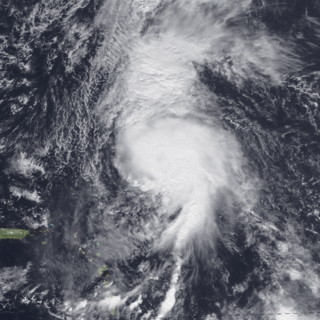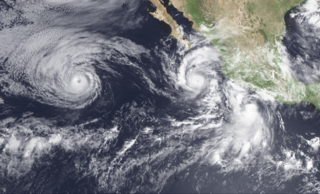Extratropical cyclones
In Europe's windstorm naming system:
- Cyclone Klaus (2009), caused substantial damage in Spain and France with at least 23 fatalities reported.
The name Klaus has been used for two tropical cyclones and one extratropical cyclone worldwide.
In the Atlantic Ocean:
The name Klaus was retired after the 1990 season because of the extensive damage and loss of life caused by the storm and was replaced with Kyle for the 1996 season.
In Europe's windstorm naming system:

The 1993 Atlantic hurricane season was a below average Atlantic hurricane season that produced ten tropical cyclones, eight tropical storms, four hurricanes, and one major hurricane. It officially started on June 1 and ended on November 30, dates which conventionally delimit the period during which most tropical cyclones form in the Atlantic Ocean. The first tropical cyclone, Tropical Depression One, developed on May 31, while the final storm, Tropical Depression Ten, dissipated on September 30, well before the average dissipation date of a season's last tropical cyclone; this represented the earliest end to the hurricane season in ten years. The most intense hurricane, Emily, was a Category 3 on the Saffir–Simpson Hurricane Scale that paralleled close to the North Carolina coastline causing minor damage and a few deaths before moving out to sea.

The 1984 Atlantic hurricane season was the most active since 1971, though the season was below average in hurricanes and major hurricanes. It officially began on June 1, 1984, and lasted until November 30, 1984. These dates conventionally delimit the period of each year when most tropical cyclones form in the Atlantic basin. The 1984 season was an active one in terms of named storms, but most of them were weak and stayed at sea. Most of the cyclones tracked through the northwest subtropical Atlantic west of the 50th meridian to near the Eastern coast of the United States between mid-August and early October. The most damaging storm was Hurricane Klaus, which caused $152 million (1984 dollars) in damage in Puerto Rico. Hurricane Diana was the first hurricane to strike a nuclear power plant without incident; it was also the first major hurricane to strike the U.S. East Coast in nearly 20 years. Also of note was Hurricane Lili, which lasted well after the official end of the season. It was downgraded from a named storm on December 24. Damage overall from the tropical cyclones in 1984 totaled $228.7 million. Unusually, no hurricanes developed from tropical waves in 1984, which usually are the source of the strongest storms in an Atlantic hurricane season.

The 1990 Atlantic hurricane season was the most active Atlantic hurricane season since 1969, with a total of 14 named storms. The season also featured eight hurricanes, one of which intensified into a major hurricane. It officially began on June 1, 1990, and lasted until November 30, 1990. These dates conventionally delimit the period of each year when most tropical cyclones form in the Atlantic basin. However, tropical cyclogenesis can occur prior to the start of the season, as demonstrated with Tropical Depression One, which formed in the Caribbean Sea on May 24.

Hurricane Klaus was a minimal Atlantic hurricane that dropped heavy rainfall across the Lesser Antilles in October 1990. The eleventh tropical cyclone and sixth hurricane of the 1990 Atlantic hurricane season, Klaus developed from a tropical wave on October 3 a short distance east of Dominica. It drifted northwestward, and quickly intensified to attain hurricane status on October 5. Though its closest approach to the Lesser Antilles was within 12 miles (19 km), the strongest winds remained to its northeast due to strong wind shear, which caused Klaus to steadily weaken. After deteriorating into a tropical depression, Klaus briefly restrengthened over the Bahamas before dissipating on October 9 under the influence of developing tropical storm, Marco.
The name Kyle has been used for four tropical cyclones in the Atlantic Ocean since 1996, the year in which Kyle replaced Klaus on the rotating six-year cycle of names used in the North Atlantic basin.
The name Alberto has been used for seven tropical cyclones in the Atlantic Ocean:
The name Cindy has been used for eleven tropical cyclones worldwide.
The name Elena was used for three tropical cyclones in the Atlantic Ocean:
The name Cosme has been used for seven tropical cyclones in the Eastern Pacific Ocean.

Hurricane Klaus was a North Atlantic hurricane that hit the Leeward Islands from the west in November of the 1984 Atlantic hurricane season. Forming from a broad area of low pressure on November 5, Klaus maintained a northeast movement throughout much of its path. After making landfall on extreme eastern Puerto Rico, it passed to the north of the Leeward Islands, resulting in strong southwesterly winds and rough seas. Klaus attained hurricane status and reached peak winds of 90 mph (145 km/h) before becoming extratropical over cooler waters on November 13. The storm dropped heavy rainfall in Puerto Rico, causing minor flooding and light damage. Klaus caused heavy marine damage in the Leeward Islands, including wrecking at least three ships. The Virgin Islands experienced heavy damage as well.
The name Edith has been used for seven tropical cyclones worldwide.

Tropical Storm Cindy was a weak but unusually wet Atlantic tropical cyclone that caused disastrous floods and mudslides across Martinique in August 1993. Cindy formed east of the island and became the annual hurricane season's third named storm on August 14. Due to unfavorable atmospheric conditions, Cindy remained disorganized throughout its journey across the northeastern Caribbean Sea. After attaining maximum sustained winds of 45 mph (75 km/h), the storm began to weaken from an interaction with the high terrain of Hispaniola. It made landfall in the Dominican Republic as a tropical depression on August 16, and dissipated over the territory the following day.
The 1891 Martinique hurricane, also known as Hurricane San Magín, was an intense major hurricane that struck the island of Martinique and caused massive damage. It was the third hurricane of the 1891 Atlantic hurricane season and the only major hurricane of the season. It was first sighted east of the Lesser Antilles on August 18 as a Category 2 hurricane. The storm made landfall on the island of Martinique, where it caused severe damage, over 700 deaths and at least 1,000 injuries. It crossed eastern Dominican Republic while tracking on a northwestward direction on August 19–20, passed the Mona Passage on August 20 and the Bahamas on August 22–23. It crossed the U.S. State of Florida and dissipated in the Gulf of Mexico after August 25. Total damage is estimated at $10 million (1891 USD). The storm is considered to be the worst on Martinique since 1817.

Tropical Storm Dorothy was the deadliest tropical cyclone of the 1970 Atlantic hurricane season. The fourth named storm and fifth tropical storm or hurricane of the season, Dorothy developed on August 17 from a tropical wave to the east of the Lesser Antilles. It tracked west-northwestward throughout its entire duration, and despite forecasts of attaining hurricane status, Dorothy reached peak winds of 70 mph (110 km/) – slightly below hurricane status. The storm struck Martinique on August 20, and subsequently began a gradual weakening trend in the Caribbean Sea. On August 23, Dorothy dissipated south of Hispaniola.

During 2007, tropical cyclones formed within seven different tropical cyclone basins, located within various parts of the Atlantic, Pacific and Indian Oceans. During the year, a total of 129 systems formed with 79 of these developing further and were named by the responsible warning centre. The strongest tropical cyclone of the year was Cyclone George, which was estimated to have a minimum barometric pressure of 902 hPa (26.64 inHg).

During 2015, tropical cyclones formed within seven different tropical cyclone basins, located within various parts of the Atlantic, Pacific and Indian Oceans. During the year, a total of 134 tropical cyclones had formed this year to date. 92 tropical cyclones had been named by either a Regional Specialized Meteorological Center (RSMC) or a Tropical Cyclone Warning Center (TCWC).

During 1993, tropical cyclones formed within seven different bodies of water called basins. To date, 110 tropical cyclones formed, of which 78 were given names by various weather agencies. Only one Category 5 tropical cyclone was formed in 1993.